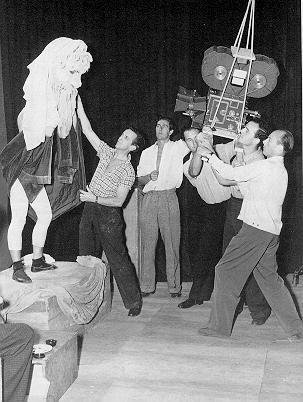Original at
Glasgow University
Chris Challis

Chris Challis, looking through the view finder on
The Red Shoes
|
Chris Challis was involved with the Archers from their second Technicolor
production, A Matter of Life and Death onwards, however his major
original contribution to the Archers came after the period which this project
is focusing on, the mid 1940s, in the final part of the Archers' lifetime,
from 1948 to 1956. He is included here because he remains a key figure
in the Archers' history due to his early presence and later importance.
Challis is an exception because all the other key figures in the Archers
were the head of their respective areas during the mid part of the company's
career, either leaving or joining in the period highlighted by this project.
Challis worked for Gaumont British News and then Technicolor in the 1930s.
He was employed as a technician on early British Technicolor movies such
as The Drum (1938) and The Four Feathers (1939) for Zoltan
Korda. After this time Challis began to work regularly with Jack Cardiff,
assisting him on the international showcase films for Technicolor, the World
Window series. Serving in the RAF during the the war he returned to Technicolor
production at its end, rejoining Cardiff as his camera operator for what
was for both men their first Archers movie.
Challis shot his first film as lighting cameraman for the Archers-produced
The End of the River (1947). This film, directed by Derek Twist
(the second and final Archers movie not to be written, produced, and directed
by Powell and Pressburger) was an an artistic and commercial failure, disliked
for its dullness by its producers despite being filmed on the Amazon river.
Unpreturbed however Challis was given the next Archers film to shoot, his
second black and white film in a row, after ten years of specialising in
colour. Reunited with art director Hein Heckroth and the Powell/Pressburger
directing team Challis realised more of his potential. The Small Black
Room, a dark tale about an alcoholic bomb defuser in the Second World
War, was the most 'real world' production of the Archers since I Know
where I'm Going with no colour or fantasy experiments. It was not shot
in the realist vein of The End of the River though. Instead it is
full of low key noir/expressionist touches, chiaroscuro lighting, claustrophobic
interiors, cluttered city streets, which are starkly contrasted with the
climax of the film on a long strip of shingle off the west country coast.
Despite the critical acclaim for the film it bombed at the box-office.
Indeed the Archers were never to regain their war-time and early post-war
success again. To take this as a reflection on Challis' contribution would
be unfair for his camerwork consistently gained plaudits from the critics
and industry.
The Archers returned to colour for their next three films, starting with
The Elusive Pimpernel(1949). Kevin Macdonald described Challis'
contribution to the following film Gone to Earth (1950). "Christopher
Challis's photography is extraordinarily vivid, and the countryside of the
Welsh Marches is brought to the screen in a series of starling images".
In his book on British cinematographers Duncan Petrie states "both The
Elusive Pimpernel and Gone to Earth, demonstrate his ability
to imbue landscape with an almost elemental quality which shapes the lives
of the characters who inhabit it".
The final round of Archers films came after a break of five years. They
shot the Technicolor operetta Oh Rosalinda! (1955), in widescreen,
where Challis and Heckroth make extensive use of the wide horizontal frame,
breaking it up with blocks of different colours, to compensate for the lack
of depth (of field) afforded by the widescreen process. After this Challis
shot in Vistavision for The Battle of the River Plate (1956), and
in black and white Vistavision for Ill Met By Moonlight, the final
Archers film.


